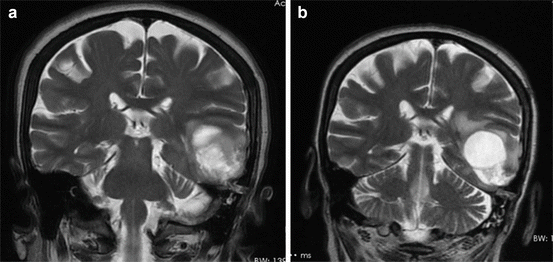, Ahmad Ameri1 and Mona Malekzadeh2
(1)
Department of Clinical Oncology, Imam Hossein Educational Hospital, Shahid Beheshti University of Medical Sciences (SBMU), Shahid Madani Street, Tehran, Iran
(2)
Department of Radiotherapy and Oncology, Shohadaye Tajrish Educational Hospital Shahid Beheshti University of Medical Sciences (SBMU), Tehran, Iran
Cranial irradiation has an important role in the treatment of brain tumors either with curative intent or for palliation. Cranial irradiation has a unique application in prevention of distant metastasis to brain parenchyma, and prophylactic cranial irradiation may be carried out in selected patients at high risk of neoplastic cranial involvement. Brain is also an organ at risk during radiotherapy of tumors which are located in base of skull and in some head and neck cancers. Cranial irradiation in any condition can cause brain injuries that are classified into three groups based on the timing of their occurrence after radiation exposure: acute (during radiation or up to 6 weeks after radiation), early delayed or subacute (up to 6 months after radiation), and late delayed (6 months or more after the completion of radiation). However in more trials, brain injury simply is defined as acute (within 90 days of the commencement of therapy) and late reactions (after 90 days of the commencement of therapy) [1]. Reports indicate that patients that undergo standard fractionated cranial irradiation and stereotactic radiosurgery may have acute brain reactions in the range of 2–40% [1–12]. However, up to 50% of patients with high doses per fraction (more than 3 Gy) to a large part of the brain may develop acute encephalopathy [3, 13].
Early-delayed reactions may present with worsening of primary symptoms or radiation somnolence syndrome (SS), which has been observed mainly after prophylactic radiation therapy for leukemia in children, with a mean incidence of 50% (in the range of 10–79% of these patients) [14–20].
It is important to differentiate brain tumor progression from radiation-induced acute injury. Pseudoprogression is defined as radiologic abnormality in postirradiation imaging because of radiation-induced injury that mimics tumor recurrence. Pseudoprogression occurs a few weeks up to 3–6 months after radiation therapy that is coincidental with early-delayed radiation reaction. The majority of patients with pseudoprogression are asymptomatic, but it can present with worsening of primary symptoms, transient cognitive decline, or somnolence syndrome [21]. Pseudoprogression incidence varies from 9% in patients treated with radiation therapy alone to 32% in patients undergoing chemoradiotherapy [22, 23]. Somnolence syndrome may develop in adults as a subacute reaction [24, 25] but have not been uniformly investigated.
3.1 Mechanism
Cranial irradiation causes vascular and cellular injuries. Endothelial cell damage, vasodilation, increased in blood-brain barrier permeability, cerebral edema, and consequent rise in intracranial pressure occur in early phase [3]. Oligodendrocytes are extremely sensitive to radiation. Subacute reactions are thought to be a result of oligodendrocyte depletion and transient demyelination [26, 27].
3.2 Timing
Brain edema could begin a few hours after the first treatment with a single dose of 2 Gy to a portion of the brain [28]. Symptoms of increased intracranial pressure or worsening of primary neurologic symptoms can occur and progress with additional fractions. With doses up to approximately 60 Gy, symptoms are usually mild and transient [29, 30].
Subacute reaction (somnolence syndrome, cognitive dysfunction, transient neurologic deficit) usually begins 4–8 weeks after treatment completion. The symptoms last from a few days to 6 weeks [14, 24, 31] and spontaneously subside over few weeks to months [20]; however, somnolence syndrome can cause long-term neurologic dysfunction [32].
3.3 Risk Factors
3.3.1 Treatment-Related Factors
Radiation therapy: Type of fractionation and fraction size, total dose [33], and field size [34] are important in the severity of acute brain toxicity. There are more acute cranial complications in the rapid course of radiation therapy with higher doses per fraction [5, 35] or multiple daily fractionated radiation therapy [1]. Risk of SS may be associated with the total dose of radiation [14] and fraction size [14, 18], but these results need further studies to be better defined [19, 36].
Combined treatment: Combination of surgery [7, 11] or radiosurgery [10] with fractionated radiation therapy seems to not significantly increase the acute complication, although surgery type (biopsy versus partial/total resection) may be a significant variable to predict the occurrence of acute brain toxicities [1]. Chemotherapy or radiation sensitizers during cranial irradiation are well tolerated without significantly increasing in acute brain toxicity [37–42]. No significant difference has been reported in the incidence of SS between patients that received radiation alone and those that received irradiation and intrathecal methotrexate [15]. An obvious increase in pseudoprogression rate occurs in patients that are treated with chemotherapy and radiation therapy versus radiation therapy alone.
3.3.2 Patient-Related Factor
Age over 50, functional status, neurological function, and mental status have not been reported to be important in the occurrence of acute brain reactions [1]. Somnolence syndrome has not been related to patient factors such as age, initial white blood count [14], and anatomical site or histological type of brain tumor [43]. Glioblastoma patients with promoter methylation of the repair enzyme 06-methylguanine-DNA methyltransferase (MGMT) are at a higher risk of tumor pseudoprogression [23].
3.4 Symptoms
In the acute phase, all presenting symptoms are related to increased intracranial pressure including headache, nausea, vomiting, and mental status changes or an exacerbation of the symptoms or signs caused by the lesion being treated [44]. These symptoms can be controlled with medication and are transient with conventional fractionation (1.8–2 Gy/day given five times per week) to a total dose of 60 Gy to the whole brain or even higher doses to limited volumes [44]. However, in very few patients with higher doses per fraction (more than 3 Gy) to a large area of brain and in patients with significant pretreatment elevated intracranial pressure, cerebral herniation may occur.
Imaging including computed tomography (CT) scan or MRI in acute radiation brain injury is usually unremarkable and could differ from no clear changes to diffuse brain swelling (Fig. 3.1) [45].


Fig. 3.1
Increased edema in a patient that treated with radiation therapy for glioblastoma multiform. (a) Before starting of radiation therapy, (b) 6 weeks after completion of radiation therapy
Somnolence is referred to as excessive drowsiness or sleep [15, 46]. The somnolence syndrome is a collection of symptoms that consists of drowsiness, lethargy, fatigue, anorexia, headache, dysphagia, dysarthria, nausea, and vomiting and is sometimes associated with low-grade fever [36, 47–50]. Brain MRI may demonstrate nonspecific white matter hyperintensity [51]. The cerebral spinal fluid (CSF) analysis of these patients shows increased levels of protein and pleocytosis [17], and electroencephalogram (EEG) shows diffuse generalized slowing in electrocortical activity more than expected for all children that receive cranial radiation [52].
Somnolence syndrome in adults may manifest with some different symptoms from pediatric patients due to much greater dosage of radiation therapy applied in adults [47]. A transient worsening in primary symptoms (e.g., epileptic seizure, increased paralysis, etc.) can develop in addition to other classic symptoms of somnolence syndrome [47]. These symptoms may be severe enough to need supportive treatment and steroid administration [24]. A transient cognitive dysfunction may occur during 6–8 weeks after the end of radiation therapy [53]. MRI findings in the postradiation phase can vary from non-enhancing white matter hyperintensities on T2-weighted imaging, indicative of edema, to an increased size of contrast-enhancing lesions within or near the irradiated tumor volume due to radiation-induced endothelial damage and blood-brain barrier disruption [22, 45].
3.5 Diagnosis
The diagnosis of acute brain reactions is based on clinical picture and response assessment to steroid treatment.
Somnolence syndrome is characterized by excessive drowsiness or sleep accompanied by signs of elevated intracranial pressure such as headache, anorexia or nausea, and vomiting. It is diagnosed based on a group of symptoms that starts 4–8 weeks after radiation therapy, especially in children.
In patients with clinical deterioration after brain radiation therapy, distinguishing between tumor progression and radiation reaction is challenging. Imaging cannot help in this regard unless in new lesions appear outside the radiation field. Symptoms related to treatment injury usually respond to escalating or starting steroid treatment. Patients closely follow-up and reimaging at approximately 4-week intervals are a logical approach in these patients [30, 54]. Biopsy is an invasive action with confounding results and is not recommended in this setting. The value of metabolic imaging like positron emission tomography (PET) scan in this situation is unclear [55]. New functional MRI techniques such as magnetic resonance spectroscopy or diffusion-weighted and perfusion seem to be promising [56]. Further investigations are needed before they are incorporated into widespread use.
3.6 Scoring
Different scoring systems have been defined for radiation-induced injury. Two of them (RTOG/EORTC and Littman SS scale) are given in Tables 3.1 and 3.2.
Definition | |
|---|---|
Grade 1 | Fully functional status (i.e., able to work) with minor neurologic findings, no medication needed |
Grade 2 | Neurologic findings present sufficient to require home case/nursing assistance may be required/medications including steroids/antiseizure agents may be required |
Grade 3 | Neurologic findings requiring hospitalization for initial management |
Grade 4 | Serious neurologic impairment which includes paralysis, coma, or seizures >3 per week despite medication/hospitalization required |
Table 3.2
Somnolence syndrome scale of Littman
Definition | |
|---|---|
None | No evidence of change in behavior |
Minimal | Disturbance with some tiredness but activity not curtailed |
Mild | Decreased activity and increased tiredness, may have a low-grade pyrexia |
Moderate | Sleeping much of the day, decreased appetite, low-grade fever, most activities curtailed |
Severe | Inactive, sleeping 18–20 h per day, low-grade fever, markedly decreased appetite, and only taking oral fluids |
Somnolence symptoms may be assessed by a patient-completed daily diary in which main symptoms like drowsiness, sleep, fatigue, lethargy, mental concentration, or appetite are scored by patients with visual analogue scales consisting of 100 mm long with opposing sensations [58]. Littman et al. [19] provided an observer-based scale (Table 3.2).
3.7 Prevention and Management
It has been recommended that pre-radiation corticosteroid administration should be considered in patients with significant peritumoral brain edema and who have symptomatic brain edema. Asymptomatic patients with minimal brain edema could be spared from pretreatment corticosteroids [59, 60].
A short course of corticosteroids may be helpful in patients with acute and subacute brain reaction to the irradiation.
Corticosteroids usually resolve the symptoms of somnolence syndrome; however, optimal steroid schedule for its management is still unknown [61]. The preventive effect of steroids [31, 36, 43] and antidepressants [62] to reduce the incidence of SS has been proposed. These results are needed to be tested in further studies before conclusion.
Dexamethasone is the drug of choice between steroids due to its long half-life, low mineralocorticoid activity, and a relatively low effect on cognition [63]. Dexamethasone causes general improvement in patient condition within 4–6 h [64, 65], and neurological improvement occurred within 24–72 h in majority of patients [66]; however, the pressure may not be consistently reduced until 2–4 days after initial dosing [67].
3.7.1 Dexamethasone Prescription
Corticosteroids have rapid and complete gastrointestinal absorption, and oral and parenteral dosing is equivalent. Parenteral therapy should be converted to oral therapy at the earliest appropriate opportunity [68].
The dose can be divided over 4 doses, but owing to its biologic half-life (about 36–54 h), dosing once or twice a day would be a rational practice [69].
Based on UptoDate “if dexamethasone dose of 16 mg is insufficient, the dose can be increased up to 100 mg per day.”
A proton pomp inhibitor like omeprazole should be coadministered for gastric protection with concomitant use of NSAIDs or bisphosphonates in the immediate postoperative period, in those patients receiving unusually high doses of corticosteroids or previous history of gastrointestinal bleeding [70].
Some guidelines recommend Pneumocystis carinii prophylaxis with trimethoprim-sulfamethoxazole in patients with dexamethasone treatment during concomitant chemoradiation therapy [63, 71].
In patients with diabetic mellitus, additional medications during steroid therapy need to be increased based on blood glucose levels.
Higher doses of dexamethasone may be needed to control brain edema in patients with anticonvulsants (e.g., phenytoin, carbamazepine and phenobarbital), due to their ability to induce hepatic microsomes [70, 72]. In addition, serum phenytoin concentration may be interfered with by steroids [73].
After maximal clinical improvement, dexamethasone dose is reduced to the lowest effective dose and after the completion of radiation therapy is tapered over 2–4 weeks and discontinued [59, 74]. A gradual tapering of dexamethasone should be considered because dexamethasone doses used in brain tumor patients can suppress the hypothalamic-pituitary-adrenocortical axis when it is given for more than 2 weeks. More importantly, gradual discontinuation of dexamethasone can prevent rebound edema and recurrence of symptoms that may occur even with less than 14 days of treatment [68]. With less than 5–7 days of steroid use, treatment can usually be abruptly discontinued [75].
There are various steroid tapering guidelines in cancer patients. Guidelines for use of steroids in cancer patients recommend that steroids be discontinued abruptly if less than 4 mg per day of dexamethasone has been used for less than 3 weeks; otherwise, a gradual tapering is indicated [76]. BC Cancer Agency Cancer Management Guidelines for dexamethasone tapering recommends reducing by 4 mg every 5 days [71]. With any symptoms returning or worsening during tapering, the dexamethasone should be return to the previous dose [77].
Because of the corticosteroid complications, other agents that can reduce vasogenic brain edema without corticosteroid side effects are under investigation. Corticorelin acetate (a synthetic peptide formulation of the normal endogenous human corticotropin-releasing factor) [78–81], vascular endothelial growth factor (VEGF) receptor, tyrosine kinase inhibitors such as cediranib or monoclonal antibodies (e.g., Bevacizumab [82, 83], and selective COX-2 inhibitors [84] are some of these medications.
References
1.
Lawrence YR, Wang M, Dicker AP, Andrews D, Curran WJ, Michalski JM et al (2011) Early toxicity predicts long-term survival in high-grade glioma. Br J Cancer 104(9):1365–1371CrossRefPubMedPubMedCentral
2.
Goetz P, Ebinu JO, Roberge D, Zadeh G (2012) Current standards in the management of cerebral metastases. Int J Surg Oncol 2012:493426PubMed
Stay updated, free articles. Join our Telegram channel

Full access? Get Clinical Tree





